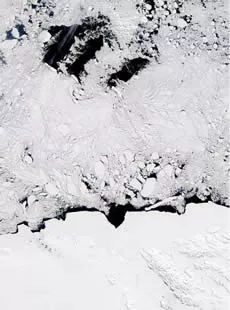Cryosphere glossary
the absolute value of the ratio between linear strain changes, perpendicular to and in the direction of a given uniaxial stress change.
in polar regions, the portion of the year when the sun is continuously in the sky; its length changes from twenty hours at the arctic/antarctic circle (latitude 66 degrees, 34 minutes N or S) to 186 days at the north and south poles.
a person working for a long time at one of the polar observing stations; Russian word is polyarnik.
a glacier entirely below freezing, except possibly for a thin layer of melt near the surface during summer or near the bed; polar glaciers are found only in polar regions of the globe or at high altitudes.
a high-latitude region covered in ice; not a true ice cap, which are less than 50,000 square kilometers (12.4 million acres) and are always over land; more like an ice sheet; also called polar ice sheet.
small, shallow depression which forms mainly in winter over some high-latitude seas within a polar or arctic air mass; its motion is approximately the same as the air stream in which it is embedded.
in polar regions, the portion of the year when the sun does not rise above the horizon; its length changes from twenty hours at the arctic/antarctic circle (latitude 66 degrees, 34 minutes N or S) to 179 days at the North and South Poles.
regions around the North and South Poles, north of the Arctic, or south of the Antarctic Circles, respectively; characterized by polar climate, very cold temperatures, heavy glaciation, and dramatic variations in daylight hours (24 hrs darkness in winter, 24 hrs daylight in summer).
large-scale cyclonic circulation in the middle and upper troposphere centered generally in the polar regions; it is often called circumpolar vortex.
in the northern hemisphere, the point in the Arctic Ocean farthest from land; in the southern hemisphere, the point on the Antarctic continent farthest from the Southern Ocean.
literally means many angled; polygons are closed, multi-sided, roughly equidimensional shapes, bounded by more or less straight sides; some of the sides may be irregular; in cryospheric science, it refers to patterned ground formations.
a pattern consisting of numerous multi-sided, roughly equidimensional figures bounded by more or less straight sides.
irregularly shaped areas of persistent open water that are sustained by winds or ocean heat; they often occur near coasts, fast ice, or ice shelves.
Image

Satellite view of polynyas (dark areas) near Oates Coast, Antarctica (solid white area at bottom of photo).
NASA
ice-bearing permafrost in which few of the soil particles are held together by ice.